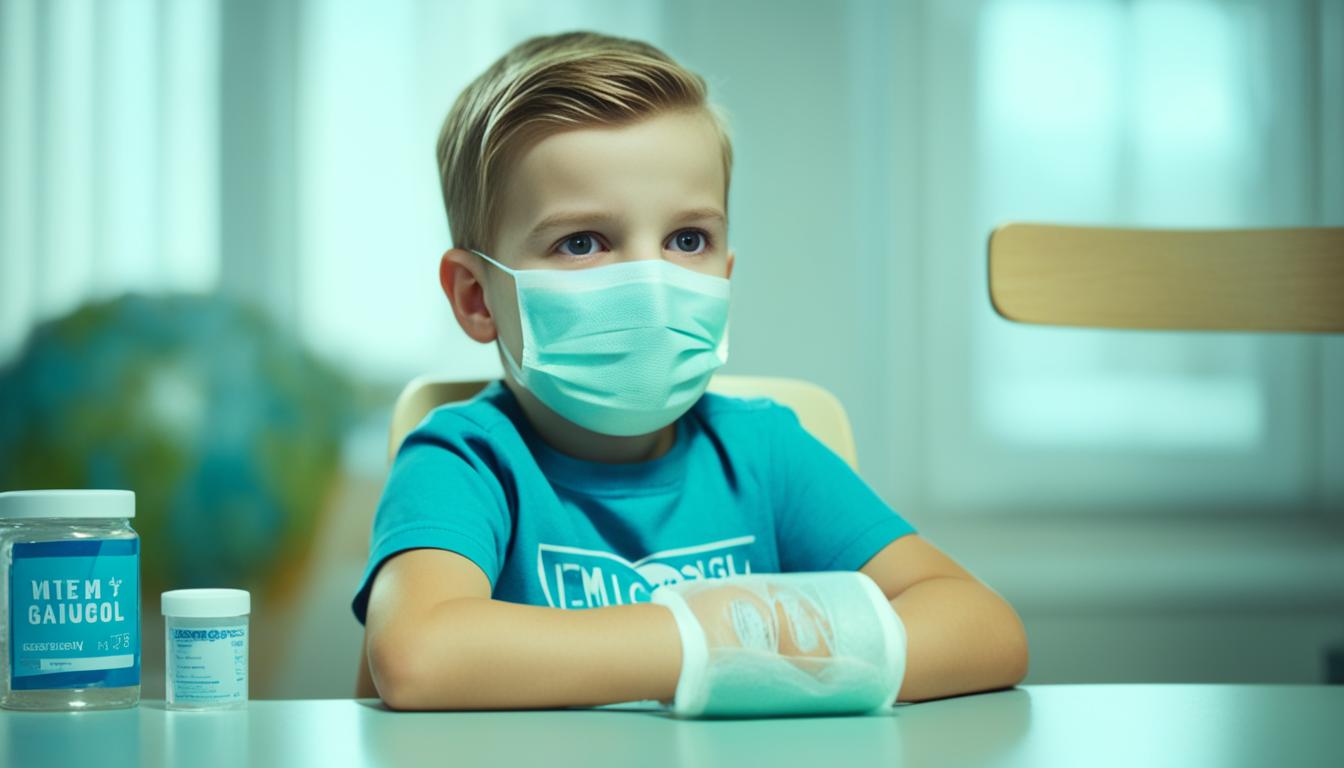It’s common to worry when your child goes through a tooth extraction. It might be because of a bad tooth, too many teeth, or an accident. This can make both you and your child anxious. But, with the right advice and help, they’ll be back to school soon.
You might be asking: When can my child go back to school after a tooth extraction? The timing depends on how well your child heals, the level of pain, and if they feel emotionally ready.
Key Takeaways
- Most dentists recommend children take at least 1-2 days off from school after a tooth extraction to monitor for complications and ensure they are comfortable.
- The recovery timeline can vary, with some kids ready to return the next day, while others may need an extra day or two of rest.
- Factors like the tooth’s condition, the child’s health, and their care after the extraction affect recovery.
- Proper pain management, keeping teeth clean, and not doing hard physical activity are key at first.
- Talking with teachers helps make the school return easier after the tooth extraction.
Understanding Why a Child May Need a Tooth Extraction
It’s natural for parents to worry when their child needs a tooth pulled. But it’s good to know some kids need this for common reasons. These include severe tooth decay, teeth growing in the wrong places, and accidents that damage teeth.
Severe Tooth Decay
Severe tooth decay can badly hurt a tooth, making it necessary to pull it out. This helps avoid more health issues in the mouth. It’s a situation that often leads to needing a tooth extraction.
Overcrowding and Misalignment
When a child’s mouth is too crowded or teeth are misaligned, pulling a tooth might be needed. This allows for better space for permanent teeth to grow correctly. It’s about making room for proper mouth growth.
Injury or Trauma to the Tooth
Sometimes, a tooth might need to come out if a child has an accident that harms it. This ensures the health of the surrounding teeth and the mouth. Such cases are also reasons for pulling a tooth.
Parents can better handle the news if they know about the [common dental issues requiring tooth removal in children] and [reasons for pediatric tooth extractions]. Learning about this can make the process of tooth extraction and recovery easier to understand.
Preparing Your Child for the Extraction Procedure
Choosing the right pediatric dentist is key for getting your child ready for a tooth extraction. These dentists are experts at working with kids. They use things like laughing gas and talk in a way that kids understand. This makes the whole process easier and more pleasant for your child.
Choosing a Pediatric Dentist
It’s important to find a dentist who knows how to work with children. They are good at making things less scary by using simple words and friendly methods. With a pediatric dentist, your child will likely be less scared and more confident about the extraction.
Explaining the Process in Child-Friendly Terms
As a parent, you have a big role in getting your child ready. Talk to them about the extraction in a way they can understand. Tell them about the numbing medicine and how the dentist will wiggle the tooth to pull it out. Make sure they know the dentist is there to keep them comfortable and safe. This talk can make the whole process better for your child.

What to Expect During and After the Extraction
At the start, the dentist loosens the tooth from the socket carefully. They use special tools like an elevator. Then, they pull the tooth out with forceps. Most kids feel pressure, not serious pain. After removing the tooth, the dentist fills the area. They ask the child to bite down. This helps stop any bleeding.
The Extraction Process
Children usually do well with tooth extractions. They’re not as hard as adult procedures. The dentist might give the child nitrous oxide gas. This gas makes them feel happy or silly before the tooth is pulled out.
Managing Pain and Discomfort
After the extraction, there might be some swelling and discomfort. This can last 2-3 days. The dentist advises using over-the-counter pain medication and cold compresses. They might also prescribe antibiotics to avoid infection.
Caring for the Extraction Site
For care, rinse the mouth with warm salt water. Also, prop your head up with a pillow. Use ice packs and avoid straws to prevent dry socket. Rest at home is important. Stay away from activities that could slow down healing.
| Recommended Soft Foods | Benefits |
|---|---|
| Smoothies and Puddings | Provide a creamy, nutrient-dense option that is gentle on the gums |
| Chilled Soups | Offer a soothing, cooling experience for the extraction site |
| Mashed Fruits and Vegetables | Easy to consume and promote healing of the extraction site |
It’s very important to listen to the dentist’s advice. Taking care of the extraction site properly helps with pain and discomfort. It also makes the recovery go smoothly.
Healing Time and Factors That Influence Recovery
When a child has a tooth taken out, parents worry about the healing time. Knowing about how long it typically takes and what factors can make it longer will make things easier for everyone.
Typical Healing Timeline
In most cases, children’s teeth heal without needing stitches. They can usually get back to normal in 2-3 days. After the first week, the pain should go down a lot. And by the second week, the swelling and pain should almost be gone. By the end of the third week, the place where the tooth was should be fully healed.
Factors That May Prolong Recovery
Recovery time might be longer for some kids. The toughness of the extraction, the kid’s health, and how well they follow their dentist’s care advice all play a part. Some might be ready for school right away, while others could need a day or two more rest. This helps to avoid problems like bleeding too much or getting an infection.
Doing too much physical stuff too soon, not keeping the mouth clean, or getting a dry socket can also slow down healing. If a child bleeds a lot, swells up more, has serious pain, or gets a fever after the tooth is out, they might need to see a doctor. These things could be signs of a bigger issue.
| Healing Timeline | Factors Affecting Recovery |
|---|---|
|
|
Understanding the healing process helps parents ready their child. It makes the recovery time easier and gets kids back to their normal routines smoothly.
Soft Food Options for Post-Extraction Diet
After getting a tooth removed, eating soft and cool foods is key. This prevents pain and tickling around where the tooth was. Experts suggest foods like smoothies, chilled soups, and mashed up fruit for the first few days.
Smoothies and Puddings
Smoothies and puddings are soft and full of good nutrients. They don’t hurt the mouth like crunchy foods and help your child heal.
Chilled Soups
Gazpacho or creamy potato soups are great for kids who had a tooth out. They are cool and gentle, making healing easier.
Mashed Fruits and Vegetables
Think of foods like bananas, applesauce, and mashed potatoes for easy meals. They are loaded with vitamins that help the body get better.
Stay away from things that are hard, crispy, or hot. They could mess up the healing. Keeping to soft, cool foods will ensure a smooth recovery for your child.

When Can My Child Return to School After Tooth Extraction?
Most dentists suggest taking 1-2 days off after a tooth extraction. This lets the child rest and keeps an eye out for any problems. Kids should avoid exhausting activities during these first days to help the healing process.
The return to school after a tooth extraction varies by child. It depends on how much pain they’re feeling, how ready they are emotionally, and if they’re following the dentist’s advice well. Some might feel better to go the day after, while others could use an extra day or two. To be safe, they should stay away from swimming, rough sports, or anything that could hurt their mouth for 24-48 hours after the extraction.

Giving your child the right rest time after a tooth pulls is very important. It helps the wound get better without problems. Listening to the dentist about what your child can and can’t do will make their recovery go better.
Resuming Physical Activities and Sports
After getting a tooth pulled out, your child needs time to heal. They should pause from physical activities and sports. Rest is key for at least a day or two after the dentist’s visit.
Waiting Period for Swimming and Contact Sports
It’s also best to delay swimming and rough sports longer. These include football, soccer, basketball, and lacrosse.
The water or hits from these sports can move the blood clot and mess with healing. Dentists suggest waiting a bit longer for these, around 1 to 2 days after the surgery. Return to swimming lessons or tough sports like football should wait several days more.
Giving the body time to heal means the area around the tooth can get stronger. This lowers risks like bleeding or infections. High school football players from schools like Louisburg Rd., Heritage, Leesville Road, Sanderson, Cardinal Gibbons, and Broughton are told to follow these rules carefully for a good recovery.
About a week later, most folks can go back to full action, even to contact sports. But, this varies based on how hard the tooth removal was and how your child’s body heals. Listening to the dentist and sharing any worries is crucial for a safe comeback to activities.
Signs of Complications and When to Seek Further Care
After a tooth extraction, watching for signs of trouble is key. Keep an eye out for a lot of bleeding, intense pain, or a fever. If your child shows these signs, call the dentist right away.
The third source stresses the need to follow aftercare rules. Things like heavy spitting, using straws, or drinking certain drinks can cause problems. It might bring on more bleeding or longer pain. Make sure to talk with the dentist if you’re not sure about anything during healing.
Being watchful and ready to act can make your child’s recovery go well. If you see any worrying signs or aren’t sure what to do, contact the dentist. They’re there to help after a tooth extraction.
Tips for a Smooth Transition Back to School
After a tooth extraction, it’s crucial to prepare for the return to class. This means talking with teachers early and getting ready for possible missed work. This can make sure your child’s school life doesn’t get too off track.
Communicating with Teachers
It’s very important to let your child’s teachers know about the tooth extraction and any special care your child needs. This helps them be more helpful and understanding. They can then assist your child in catching up on missed lessons.
Preparing for Missed Schoolwork
Together, plan for any schoolwork your child might miss. Since a tooth extraction can mean a few days off, being ready is key. By talking with teachers early and getting set, you make it easier for your child to return to school smoothly.
Managing Anxiety and Emotional Support
A tooth extraction can make a child anxious and nervous. Dentists at Prime Pediatric Dentistry know how to help. They use nitrous oxide and talk in a way that kids understand. This makes the procedure less scary for the child.
However, the days after may be tough too. The child might worry about how they look or what they can eat. As a parent, I’m key in giving my child emotional help. This could mean comforting them, talking openly, and doing fun, calming things.
By doing this, I can make sure my child feels better and has a good recovery. It’s about dealing with my child’s worries after the extraction. And offering support while they heal can turn this into a positive time.
Oral Hygiene Practices During Recovery
Keeping your mouth clean after a tooth extraction is key, especially for kids. Dentists for kids suggest rinsing with warm salt water. This should be done a few times each day. It cleans the spot, helping to avoid infection. This simple step also speeds up the healing process.
Gentle Brushing and Rinsing
Kids should brush their teeth carefully after surgery, as the second point highlights. It’s vital they don’t brush too hard. A soft toothbrush will be gentle enough. This way, they won’t harm the healing area.
Also, children should avoid using straws and drinking fizzy or hot drinks. These can mess up the blood clot that forms over the extraction site. Doing this helps them heal well without trouble.
Helping Your Child Cope with Dietary Changes
After your child’s tooth extraction, you might worry about their diet change. It’s common for kids to find the shift to soft, cool foods hard. But, you can guide them through this with some smart choices. This will help them eat well while they heal.
Start by offering tasty soft foods that are also good for them. Things like smoothies, puddings, and cool soups work well. They’re full of nutrients but won’t harm the healing place. Also, mashed fruits and veggies are great. Think bananas, applesauce, and mashed potatoes. They’re soft on the gums.
Letting your child help make meals can be very positive. They might enjoy picking smoothie flavors or helping with dishes. This makes them feel part of their healing journey. It also boosts their self-confidence.
Watch out for food that’s too hot or hard. These can be bad for the new gap in the teeth. Instead, go for foods that are cold and easy to eat. They’ll help your child feel good and heal faster.
Know that this diet change won’t last forever. Soon, your child will get back to eating normally. Your creativity and understanding will get them through this change. By being there and supporting them, you’re making a big difference.
When to Schedule a Follow-Up Appointment
After your child’s tooth is removed, keeping in touch with the dentist is key. They’ll suggest when your child can eat and do things normally again. Your dentist will also tell you when to come back to check how the healing is going and to answer any questions.
Dentists often recommend a follow-up visit within a week or two after the tooth removal. This is to see how well the healing is doing and to spot any problems early. Setting up this next appointment is vital to help your child get used to diet changes and to keep track of their healing.
At this follow-up, the dentist might give more advice on looking after your child. They’ll cover things like when it’s okay for your child to go back to playing sports or their normal brushing routine. Staying in touch with the dentist is critical for a successful recovery after the tooth is taken out.
FAQ
When can my child return to school after a tooth extraction?
After a tooth extraction, most dentists recommend 1-2 days off from school. This time allows rest and checks for any problems. If the child feels ready and follows care instructions, they can go back.
What are the common reasons a child may need a tooth extraction?
Severe tooth decay, too many teeth, and injury are key reasons. Severe decay can lead to health issues, so the tooth must be removed. Too many or misaligned teeth sometimes need space, so a tooth might be pulled. If a tooth is hurt badly, it might not be able to stay.
How can parents help prepare their child for the tooth extraction procedure?
Parents can pick a dentist who knows how to work well with kids. Such dentists use things like laughing gas and simple words to make kids feel better. Helping a child know what will happen also makes things smoother.
What can parents expect during and after the tooth extraction?
The dentist will gently take out the tooth using special tools. The child might feel some pressure but not real pain. After, there might be swelling and some pain. This usually lasts only a few days, mostly helped by medicine and cold packs.
How long does it typically take for a child to heal after a tooth extraction?
Most often, the tooth hole heals by itself without stitches. Kids can usually go back to regular activities in 2-3 days. The time it takes to get better can change based on how hard it was to take out the tooth and if the kid follows what the dentist advises.
What soft food options are recommended for a child after a tooth extraction?
Dentists suggest children eat soft, cold foods for a while. This includes foods like smoothies, pudding, and mashed fruits and veggies. These foods are easy on the mouth and help it heal.
How long should my child avoid physical activities and sports after a tooth extraction?
Kids should not do hard activities, swimming, or sports that involve contact for one to two days after getting a tooth pulled. This break helps the mouth heal properly.
What are the signs of complications after a tooth extraction, and when should I contact the dentist?
Watch for heavy bleeding, bad pain, or a fever after the dentist visit. If the child has these signs, get in touch with the dentist soon.
How can I help my child’s transition back to school after a tooth extraction?
It’s wise to let teachers know about the procedure and any limits on what the child can eat or do. This makes it easier for the child to catch up and feel supported.
How can I help my child cope emotionally during the recovery process?
Be there for your child and talk openly to help them deal with any worries or sadness. Offer to do calm activities with them, and make sure they feel safe and loved.
What oral hygiene practices should my child follow during the recovery period?
Children should wash their mouth with warm salt water many times daily to keep it clean and avoid sickness. Also, teach your child to brush gently around where the tooth was pulled.
When should I schedule a follow-up appointment with the dentist after the extraction?
The dentist will say when to return for a checkup. This visit is to make sure everything with the mouth is getting better and to answer any questions you might have.








